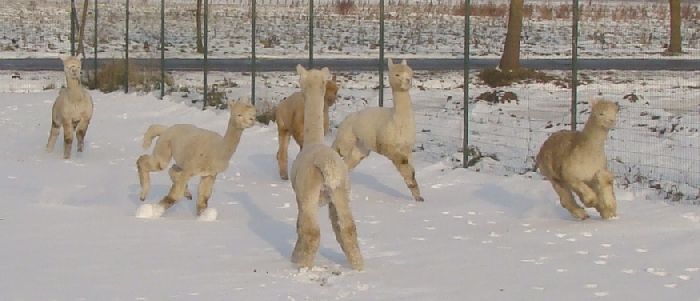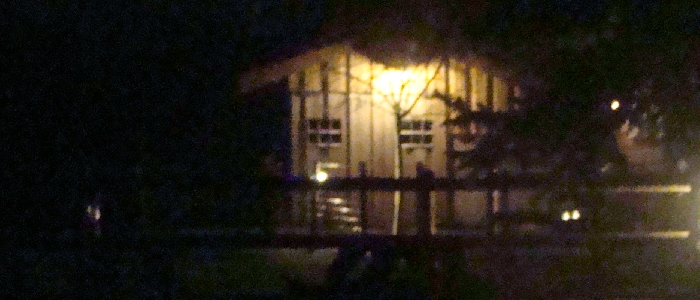Zorg van de moeder
MUM’S THE WORD
By Linda Blake Southern Alpacas Stud
So, your alpaca has birthed, and all the focus is on the new cria. In all the excitement of heralding a new alpaca life, do remember the mum ! Much has been written about the cria’s progress, but not as much about mum.
Here are some crucial things to watch for in the mum once she has birthed - good observation is needed, and most of these will require your vet assistance. And as I always stress at the neonatal courses, do remember that 95% of births are normal !
Placenta Passing - within 6-8 hours of birth
Watch for the placenta to appear, then check it for wholeness - smooth edges, no obvious broken bits. A torn placenta may mean that placental tags have been left behind attached inside mum and these can lead to infection, as can a retained placenta. The placenta should have passed within six to eight hours after birth, or for a late in the day birth, by early the next morning.
If mum has a placenta still attached and hanging out, let it come naturally. Do not pull it. If the mum has it attached several hours later, or has not passed the placenta at all, or you think not all of the placenta is out, get the vet. The vet may give an injection of oxytocin to help the uterus contract and expel the placenta, and may have to manually remove any bits of placenta, and detach any tags from deep inside mum.
Too much fresh blood - on birthing
"There’s an awful lot of blood" - words that bring fear into my heart. Birthing involves blood, and you’ll notice more on a white or light coloured mum than a darker one. There will be some bleeding immediately after birth, but it should soon be just a dribble that stops within the hour. But a gush of fresh blood can mean a tear or rupture inside. A mum can die in 10 minutes from blood loss and shock. Call the vet.
It can also be the placental cord breaking and not sealing off - which can affect both mum and cria. In the last stages of birthing the placental cord stretches, and this seals it off before breaking. If it is not stretched enough, as in an assisted or hurried birth, it may not seal, resulting in blood loss from both cria and mum. Take action quickly.
For mum, reach inside and find the cord, and stretch it between your thumb and fingers to create the sealing to stop the blood flow. For cria, attach a clamp to its umbilical cord. Improvise with a bull dog clip, cotton tied tightly, or folding the cord and holding tight in your fingers, stretching it to seal.
Blood can attract flies, so wash off what you can, and consider trimming back fibre that is blood caked.
Tears - on birthing, and monitor after birthing
It is always a wonder to me how that small opening in mum expands to allow a cria to pass out. At times the sizes do not match - too small a mum or not enough softening of the tissues, or too large a cria - and then there may be tears. If you have any doubts at all, do physically check - lift the tail and check the vulva area. You can see any tears on the outside, but there may well be tears just inside as well.
If mum’s uterus, vagina or vulva are torn or damaged in birthing, any repairs need to be attended to within 24 hours of the birth. Tears can also lead to internal scarring, which is counter-productive to a breeding female. It makes her difficult to get pregnant, especially if mating re-opens the scars and they bleed - blood is a spermicide. Or worse, it may make birthing difficult.
Most superficial tears will minimise in size as mum contracts down. If flies are bothering mum, wash off blood and trim away bloody fibre. Clean the tears and apply a sticky antibiotic ointment like Betadine that will cover the tear. Antibiotic cover is advised for tears, preferably by injection.
Look under mum’s tail daily for the first few days after birth. Watch for discharges and act quickly. Tears can infect really easily in the warm moist inside of a female. Do not delay - infections from birthing can kill the mum within days.
Uterine Prolapse - during or soon after birth
"The placenta has passed, and now something else like it is coming out as well" said a client on the phone to me. What she was seeing was the uterus prolapsing - turning inside out and coming out. It does look a bit like a placenta, but it is fleshy and meaty in appearance and dark red, compared to the lighter red placenta which is translucent and usually full of liquid.
Uterine prolapses may be partial or complete, and they may have the placenta still attached. Act immediately - call the vet. Prolapses are rare - I’ve only ever been involved in assisting with one.
The uterus remains connected to mum’s backside, and hangs out. It will dry out and swell, and get dirty. It needs to be kept clean and moist - use a damp towel to wrap around it. This is far easier said than done, but mum may well sit down. Put a clean towel or ground sheet on the ground for the uterus to rest on, and lay a damp towel on top to keep it moist until the vet arrives to re-insert it.
Have buckets of water and lots of people on hand to assist with restraint of the mum and help the vet clean and re-position the uterus. Usually an epidural is involved to stop mum straining, and help get this large object re-inverted and back in through a very small hole. Sutures may be used to keep the prolapse in.
Vaginal Prolapse - before and/or after birth
"There’s a big pinky bit of flesh protruding from one of the females", I said anxiously to the vet. I couldn’t even tell which orifice it was coming out of. By the time he arrived, the female looked perfectly normal. Could she have pulled it back in again ? Whilst we scratched our heads and watched, she kinda burped and then her vagina poked back out again !
Vaginal prolapses can occur both before and after birth. Usually these are poked back inside and the opening sutured up to stop them coming back out. If this is before birth, it is important that you keep close watch so the stitches can be cut before the baby is born.
Rectal Tear - prior to/during birthing
"It looks like the cria is going to come out the anus - you can see the head pushing in that area" say owners in fright. My reassurance falls on deaf ears as it does look ominous. Generally this is just the positioning for birthing and can start a fortnight before birthing. And the mum will birth vaginally.
I’ve only once seen the horrid results of a rectal wall tearing, where the entire uterus with cria inside it comes out the anal area. It is a quick death for mum and cria, from bloody haemorrhaging. I found mum dead on the dawn birthing round, but even if it had happened during the daytime watch, it would probably, with the bleeding, have still been death that resulted for both.
Other Discharges - within days of birth
Now mum has birthed, take almost as much interest in her rear end as you did before birthing ! Look under her tail when she is at the dung pile, and hold her for a closer look if she remains swollen in the rear.
Do check any discharges - a sniff will soon tell you if it indicates any infection in mum. Any yellow discharge, or pus, or a lot of blood, requires immediate vet attention.
Rarely seen, but usually passed a few days after birthing, is a thick pinky mucus or glob of tissue. To me, it looks and feels like the fatty bit I cut off the chicken meat before cooking it. This is normal, and is of no concern. There may also be a small amount of fluid discharged, and it may be blood tinged, within the first 5-7 days of birthing. Again normal.
Assisted birth
Any assisted birth, whether a dystocia or not, puts a mum at risk of infection. Antibiotic cover by way of an injection and/or insertion of a foaming pessary is essential - call your vet to do this as arm length gloves are needed to get the pessary in through the cervix, and it needs to be done before the cervix starts contracting down again.
Milky Concerns
After a normal birth we like to hold mum and check her teats, stripping out any wax, and expressing the first few drops of milk, to make it easier for the cria to feed. We like to keep close watch and ensure that the cria is feeding within 3 hours or so of birth.
The milk often does not come down until the placenta has passed, so if the placenta is slow to come, then the milk may be as well. Mums seem to know this, and may not let their cria feed until they have milk.
If there is a lack of milk, it can be due to a nervous or first time mum, a poor milker, mastitis or udder edema, or refusal to let milk down.
You can get a mum to let her milk down quite quickly with an oxytocin injection, or you can painstakingly use a cut-off syringe to manually express the milk and collect it for feeding the cria.
Mastitis is an infection in the mammary glands. Indications are enlargement, tenderness, excessive warmth, or blood in the milk, and hence the mum may refuse to let the cria feed. Mastitis is rare and treatable. Udder edema is an accumulation of fluid in the tissue around the mammary glands, which may feel swollen and firm. The swelling may make the normal size teats appear small, and make it difficult for the cria to latch on. Call the vet in both instances.
Occasionally a mum will get one enlarged teat, which is usually an infection. Sniff the milk from the teat - do NOT taste it, as some of the teat infections are real nasty. Ask your vet for advice on whether to milk the teat out or let it stay engorged and dry that teat off.
If your cria is not getting enough milk, for whatever reason, you need to be on to it asap. Otherwise three days is about as long as the cria will last before it starves.
Weight and feeding - before and after birthing
Feeding a cria can take a lot from a mum. If the mum is underweight or loses a lot of weight early in lactation, supplementation is desirable for the dam’s health.
We now feed a high protein muesli mix to our dams in late pregnancy and early in lactation. Mums that have special needs are kept in a close paddock and supplemented individually. Nic has formulated this muesli from a study of the pregnant and lactating alpaca’s nutritional needs. They love the mix, and as it is not grain-based, are able to eat as much as they want without any ill effects - although we do measure out about 300 grams each a day.
Summary
Take as much interest in, and notice of, your dam after birth as you do before birth. It will make all the difference to picking up any unusual signs that indicate she needs some health help.
Re-assurance - all of the dreadful things described above can occur, and after a period of rest and healing, mum can be re-mated and will birth again. In all the cases I’ve been involved with - from prolapsed uterus to caesarean - the mums have gone on to have perfectly normal births next time around.
[2009-02-23 door Linda Blake]







